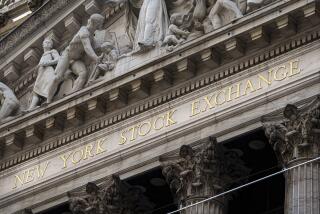Bond Fans Wonder if They Should Try to Lock In Yields
President Bush is practically pleading with Americans to get the economy moving again. But a lot of bond investors like things just the way they are.
The weak economy continues to pull interest rates dramatically lower, and the rally shows no sign of abating. Friday, bond yields fell again on news that business created just 24,000 new jobs nationwide in September--a paltry total that suggests that there is little or no economic growth out there, and thus little demand for money.
That’s terrible for job seekers. But anyone savvy enough to buy bonds last summer is feeling like a genius today.
If you bought 3-year Treasury notes as recently as August 22, you locked in a yield of 6.64%. Today, a buyer of 3-year Treasurys gets 6.14%--a full half-point less.
An investor’s problem now is trying to figure out whether it’s still worth locking in bond yields. Experts’ best guess: Yields will go even lower before this year ends, because the current bond rally looks like it’s picking up steam.
Beyond that, few bond pros believe that there will be a slide in interest rates next year to rival what’s happened this year--unless the economy collapses.
Even so, bonds may still pay more than money market funds or bank CDs over the next year.
Many individual investors buy bonds via mutual funds, which pool the cash of thousands of small investors to buy a large number of bonds. The accompanying chart shows how various categories of bond funds performed in the period ended Sept. 30.
A few highlights:
* The average fund that owns long-term Treasury bonds (maturing in 10 years or more) posted a return of 5.69% in the third quarter, according to fund-tracker Lipper Analytical Services in New York. “Total return” counts both the interest you earned from the bonds and the change in their principal value.
Because yields on new bonds fell in the quarter, investors got a big boost as older, higher-yielding bonds appreciated in value. Dissecting that 5.69% return, about 2 percentage points represented the funds’ interest earnings in the quarter. The other 3-plus points were the jump in the bonds’ value.
* The slide in market interest rates produced big returns for most other types of bond funds as well. Funds that own Treasury bonds maturing in five to 10 years rose 5.3% for the quarter; those that own high-quality, long-term corporate bonds gained 5.86%; and funds that buy high-yield corporate junk bonds leaped 6.64%.
* To put those returns in perspective, investors in short-term money market funds took home 1.34% in interest for the quarter. Not much competition for bonds.
* For the nine months ended Sept. 30, bond funds’ returns mostly ranged from 7.5% up to a stunning 30% on junk bonds. Basically, bonds this year have worked the way they’re supposed to: Bonds of the longest term and highest risk generally have paid you the most; shorter-term and lower-risk bonds have paid less.
What few bond owners want to consider is what would happen if market interest rates begin to rise at some point in the near future. If the economy suddenly starts to expand at a brisk pace, demand for money could rise, and so could interest rates.
If that occurs, older bonds would depreciate in value, reversing the appreciation of recent months. You can see how total return becomes a two-edged sword: If market rates go up and your bonds fall in value, the loss of principal can negate your interest earnings.
But does anyone really believe that the economy is going to boom soon? Not David Schroeder, who manages the $256-million Benham Treasury Note Fund in Palo Alto, Calif. “I don’t see any signs of real strength in the economy at the moment,” he says.
Even so, he’s not betting on a stunning further decline in interest rates. The average maturity of Treasury securities in his fund is 3.85 years. The portfolio is paying shareholders an interest yield of about 6.2%--a full percentage point higher than the average money market fund yield.
If Schroeder believed that rates were going to drop substantially, he would shift the portfolio to longer-term, higher-yielding bonds. But when he compares yields of 7.38% on 10-year Treasurys with yields of 6.78% on five-year Treasurys, he says, “There’s not much more bang for your buck” to buy the longer-term bonds.
Yet Schroeder also admits that he’s been surprised how fast long-term yields have fallen in recent weeks. The 30-year Treasury bond yield has tumbled from 8.01% in mid-September to 7.78%. “I thought we’d have trouble getting through 8%,” Schroeder says.
For investors who want to hop on board the bond market, the smartest strategy may be to hedge your bets: If you split your money among bond funds of shorter terms (say, 1 to 5 years) and longer terms (10 years-plus), you can balance yourself against the risk of market rates moving either way up or way down over the next year.
And if the economy’s growth remains anemic well into 1992, and interest rates stay about even, bonds will give you much better returns than money funds and other very short-term accounts.
What About Junk? Almost nobody thought high-yield corporate junk bonds would rebound as dramatically as they have this year. As noted earlier, an investor who bought the average junk fund at the start of the year has reaped a return of almost 30% so far.
What now? If you buy a junk fund today, your annualized interest yield will probably be in the 11% to 13% range. The big question is, even if market interest rates keep falling, will junk bonds continue to appreciate in value as rapidly as they have this year?
Very unlikely, say most junk mutual fund managers. Investors had pushed the prices of junk bonds to ridiculous lows early this year, figuring that many of the companies that issued the bonds would end up in bankruptcy. Plenty have--but certainly not most. So the good bonds have roared back.
Now, even the junkiest of the junk issuers--companies that have actually defaulted on their interest payments--have seen their bonds bid up by speculators. That hasn’t left a lot of bargains out there. “We don’t find many defaulted bonds worth buying today,” says Paul Debban, managing director of the Reorganized Securities Group in Los Angeles.
Many junk bond managers say they’re busy upgrading the quality of their portfolios, in case the economy slides into a new recession. “I’m not going out and buying very high-yield bonds of companies that have a lot of ifs, “ says Martin Wiskeman, manager of the $1.7-billion Franklin AGE High Income Fund in San Mateo, Calif.
His fund, which yields about 11.8%, is heavy with bonds of higher-quality junk issuers such as RJR Nabisco, Kroger and Safeway.
Ron Lout, who manages the $100-million Financial Funds High Yield Fund in Denver, also has taken advantage of junk bonds’ rally to dump those whose prospects appear less than solid should a new recession slam junk companies’ sales and earnings.
Lout worries that a selloff in junk could quickly spiral out of control. He notes that insurance companies and S&Ls; have mostly been selling their junk holdings this year. Mutual funds and private investors have been the big buyers. If demand from the latter were to dry up, “there’s no one there to catch” the bonds, he warns.
How Bond Mutual Funds Have Fared
Here are returns for key categories of money market and bond mutual funds for the period ended Sept. 30. Figures are for “total returns”: They measure the yield investors were paid in the period, plus or minus any change in the funds’ share value.
Total investment return, periods ended Sept. 30:
Fund category Quarter Nine mos. Five years Ten years Junk corporate bonds 6.64% 29.98% 32.65% 218.45% High-quality corporate bonds, long-term 5.86% 10.56% 50.45% 262.59% U.S. Treasurys, long-term 5.69% 8.91% 47.18% 222.53% U.S. Treasurys, 5- to 10-year 5.30% 8.87% 44.52% 181.33% GNMA bonds 5.12% 9.42% 54.50% 275.75% High-quality corporate bonds, 5- to 10-year 5.07% 9.78% 48.21% 230.35% Municipal bonds, long-term 4.01% 8.30% 45.21% 244.09% High-quality corporate bonds, 1- to 5-year 3.48% 7.94% 46.27% NA U.S. Treasurys, 1- to 5-year 3.45% 7.49% 43.99% 221.21% Municipal bonds, 5- to 10-year 3.14% 7.12% 39.27% 161.88% Municipal bonds, 1- to 5-year 2.16% 5.66% 34.02% 100.50% Money market instruments 1.34% 4.41% 40.92% 122.38%
Source: Lipper Analytical Services Inc.
Los Angeles Times
More to Read
Inside the business of entertainment
The Wide Shot brings you news, analysis and insights on everything from streaming wars to production — and what it all means for the future.
You may occasionally receive promotional content from the Los Angeles Times.










